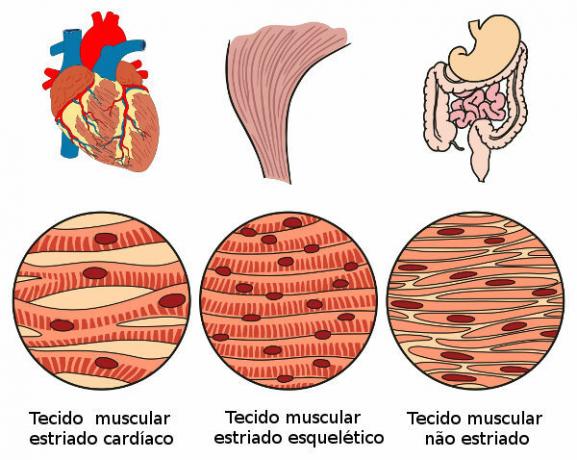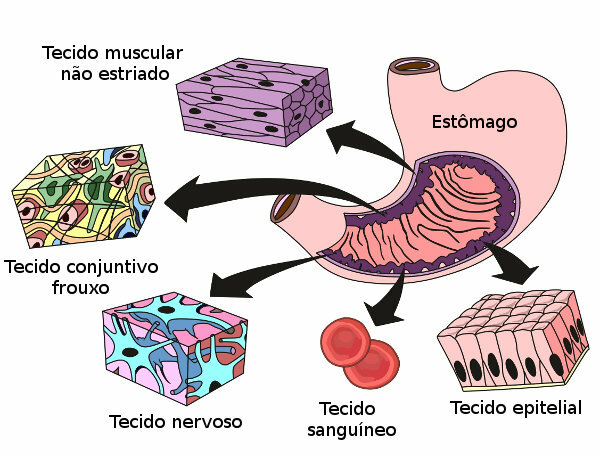O Human Body it is formed by several organs and systems, which work together to guarantee the perfect functioning of the organism. If we look at the microscopic level, we can perceive the presence of thousands and thousands of cells, which form the tissues, organs and systems, a characteristic that allows us to state that human beings are organisms multicellular.
Read too: Human Skeleton: Bone Names, Functions and Divisions
→ Levels of organization of the human body
The human body can be analyzed at different levels of organization. We can study cells, tissues, organs or even different systems. Considering cells as the first hierarchical level of organization, we have:

At cells are considered the functional and structural units of living beings. In our body, we find thousands of cells and, therefore, we are classified as multicellular organisms. The cells found in our body are eukaryotes, that is, they have a defined core and membranous organelles.
Read too: Stem cells
In multicellular living beings, a group of similar cells that perform the same function is called
fabric.We have four basic types of tissue in our body: epithelial, connective, muscular and nervous.The fabrics can be organized in organs, which are defined as groupings of tissues that perform some specific functions. The organs, in turn, can be interconnected forming systems, that perform even more complex functions.

The human body has several organs, which have specific functions to ensure the functioning of the body as a whole.
To better understand these levels, let's imagine, for example, the osteoblasts, osteocytes and osteoclasts. These cells are from the bone tissue, which is responsible for forming the bones, organs that make up the skeletal system. The skeletal system, along with other systems such as the digestive, muscular, cardiovascular and nervous, make up the human body.
→ human body cells
The human body has different cell types, which perform the most varied functions. Here are some cell types found in our bodies and their function.
adipocytes: cells that store fat.
Schwann cell: produce the myelin sheath of neurons.
beta cells: cells in the pancreas responsible for producing insulin.
Chondroblasts: young cartilage tissue cells that form the cartilage matrix.
Chondrocytes: Cartilaginous tissue cells, derived from chondroblasts, that occupy gaps in the cartilage matrix.
Sperm: male gametes.
Red blood cells, erythrocytes or red blood cells: blood cells that ensure the transport of oxygen throughout the body.
Hepatocytes: liver cells that synthesize proteins and bile, in addition to ensuring the detoxification of various substances.
Leukocytes or white blood cells: blood cells that act in the body's defense. The types of leukocytes that exist are neutrophils, eosinophils, basophils, lymphocytes and monocytes.

In the human body, it is possible to observe different cell types.
Neurons:cells responsible for transmitting nerve impulses.
osteoblasts: bone tissue cells responsible for producing the organic part of the bone matrix.
Osteocytes: mature bone tissue cells that derive from osteoblasts and are found in gaps in the bone matrix.
Osteoclasts: bone tissue cells that act in the resorption of this tissue.
oocyte: female gamete.
→ human body tissue
Epithelial tissue: its most important feature is the presence of juxtaposed cells with little extracellular matrix. It can be classified into two basic types: lining epithelial tissue and glandular epithelial tissue.

Epithelial tissue is characterized by the presence of cells close together.
Connective tissue: Its main characteristic is the presence of a large amount of extracellular matrix, a characteristic that differentiates it from the epithelial tissue. There are several types of connective tissue, namely: connective tissue itself, adipose tissue, blood tissue, cartilage tissue and bone tissue.
Muscle tissue: stands out for the presence of cells with the capacity to contract. We can classify muscle tissue into three types: non-striated or smooth muscle, striated skeletal muscle, and striated cardiac muscle.

Muscle tissue has the ability to contract and can be classified into three different types.
Nerve tissue:it has cells capable of capturing, interpreting and transmitting so-called nerve impulses.
→ Organs of the human body
A human organ can have several tissues, as you can see in the following diagram:
Do not stop now... There's more after the advertising ;)

Note the various tissues found in the stomach, an organ of the digestive system.
All the organs in our body are important, but some are vital and some are not. See some examples below.
Bladder: urine storage site after the formation of this product by the kidneys.
Heart:organ responsible for pushing blood to the body. Thanks to this pumping, cells are able to acquire oxygen and other necessary nutrients.

The heart is a muscular organ responsible for pumping blood to the body.
Esophagus: muscular tube that ensures that food is taken from the mouth to the stomach.
Stomach: organ of the digestive system in which part of the digestion takes place. It is responsible for producing gastric juice and transforming the bolus into chyme.
Read too:stomach noise
Small intestine: where the end of the digestion process and the absorption of a large part of the nutrients removed from food takes place.
Large intestine: where water absorption and faeces formation take place.

The small intestine and the large intestine are part of the digestive system.
Larynx: this organ of the respiratory system joins the pharynx with the trachea. It is in the larynx that the vocal folds are found.
Ovaries:exclusive female organs where female gametes and female sex hormones are produced.
Pancreas: mixed gland responsible for producing pancreatic juice and two important hormones (insulin and glucagon), which act to regulate the rate of glucose in the blood.

The pancreas is responsible for the production of pancreatic juice and the hormones insulin and glucagon.
Lungs:spongy organs of the respiratory system rich in alveoli, which are the places where gas exchange takes place.
Read too: pulmonary embolism
Kidneys: organs of the urinary system where urine is produced.
Testicle:male-only organs where male gametes and male sex hormones are produced.
Fallopian tubes: part of the female reproductive system where fertilization usually occurs.
Uterus: part of the female reproductive system where the embryo develops during pregnancy.
→ Main systems of the human body

The human body has several systems, which ensure, for example, the uptake of oxygen, the use of nutrients and locomotion.
Cardiovascular: consisting of the heart and blood vessels, it ensures the circulation of blood throughout the body and, consequently, the transport of oxygen and nutrients to all cells.
Digestive: Formed by the mouth, pharynx, esophagus, stomach, intestines and attached glands, it is responsible for ensuring the breakdown of food, transforming them into smaller particles that can be used.
Endocrine:it is formed by all the body's endocrine glands, which are responsible for the production of hormones, which, in turn, act in the chemical regulation of the body's various activities.
Skeletal:Consisting mainly of bones, it is related to functions such as the protection of internal organs, locomotion, support, calcium storage and production of blood cells.
Excretor:also known as the urinary system, it is formed by the kidneys, ureters, bladder and urethra and is responsible for the production and elimination of urine.
Muscle: it is formed by muscles and is related to the movement of our body and contraction of organs.
Nervous:it is responsible for ensuring the perception of internal and external stimuli and generating responses to these stimuli. Thanks to this system, we are able to memorize, coordinate, speak, feel, see and learn.
Breeder:it is the system responsible for our reproduction. O female reproductive system ensures the formation of female gametes and the baby's pregnancy. O male reproductive system it is responsible for the production and transfer of the male gamete to the female.
Respiratory: Formed by the nose, pharynx, larynx, trachea, bronchi, bronchioles and alveoli, it is responsible for ensuring gas exchange.
Integument: is formed by skin, hair, nails and glands and acts in various functions, such as a barrier against water loss and entry of microorganisms, as well as regulating body temperature.
By Ma. Vanessa Sardinha dos Santos
Would you like to reference this text in a school or academic work? Look:
SANTOS, Vanessa Sardinha dos. "Human Body"; Brazil School. Available in: https://brasilescola.uol.com.br/biologia/corpo-humano.htm. Accessed on June 27, 2021.


